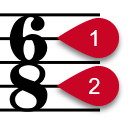Time signatures
Time signatures indicate the meter of music, and apply to all bars from where they first appear until a subsequent change of time signature. Meter describes the rhythmic pulse of music, and its division into beats and bars.
A time signature is made up of two parts: numerator on top, and denominator underneath. These are the same mathematical terms as are used for fractions due to their similar arrangement. Depending on your project-wide settings for time signature style, numerators and denominators can have different appearances.

-
Numerator
Specifies the number of beats in each bar for the time signature. The duration of beats is specified by the denominator.
-
Denominator
Specifies the beat duration for the time signature. The denominator doubles for every halving of the beat duration: 1 is a whole note (breve), 2 is a half note (minim), 4 is a quarter note (crotchet), 8 is an eighth note (quaver), and so on.
For example, a 4/4 time signature tells you the bar is made up of four beats, and each of those beats is a quarter note in length. A time signature of 4/2 contains four half notes in each bar, and 4/8 contains four eighth notes (quavers) in each bar. Both 3/4 and 6/8 contain six eighth notes, but it is understood that a 3/4 bar contains three quarter note beats, whereas a 6/8 bar contains two dotted quarter note beats.
Bars are rhythmic groups, divided according to the time signature, and they make following the music much more practical and easier to read. Notes are beamed differently in different time signatures for the same reasons.
By default, time signatures apply to all staves. However, there are certain situations, such as in polymetric music, where some parts require their own time signature, independently of the rest of the ensemble. You can input time signatures that apply to all staves or only apply to single staves in Dorico Pro.
Time signatures apply until the next time signature change or the end of the flow, whichever comes first.
Time signatures traditionally use a unique, heavy font that ensures they stand out against staff lines, and fill the height of a single staff. For some types of music, particularly film music, it is typical to use large time signatures that span several staves.
-
You can input notes without inputting a time signature.
-
Beat lengths are fixed across all staves in your project, regardless of the time signature. For example, if you have a 2/4 time signature on one staff and a 6/8 time signature on another staff, then one quarter note in the 2/4 time signature equals one quarter note in the 6/8 time signature, meaning their barlines do not match.
-
Dorico Pro does not automatically add beats to fill bars when you input time signatures unless Insert mode is activated.

Figure 1. A 5/8 time signature input before an existing 4/4 time signature without Insert mode activated, leaving only three eighth note beats in the second 5/8 bar.